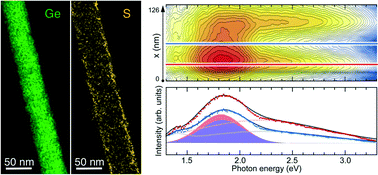Formation of Ge–GeS core–shell nanostructures via solid-state sulfurization of Ge nanowires
Abstract
Germanium nanowires (NWs) have attractive properties for a variety of applications, including micro- and optoelectronics, memory devices, solar energy conversion, and energy storage, among others. For applications that involve exposure to air, the poor chemical stability and electronic surface passivation of native oxides have remained a long-standing concern. Termination by sulfur-rich surface layers has emerged as a promising strategy for passivation of planar Ge surfaces. Here we discuss experiments on solid-state sulfurization of Ge nanowires in sulfur vapor at near-ambient pressures and at different temperatures. Combined transmission electron microscopy imaging and chemical mapping establishes that Ge NWs remain intact during vapor-phase reaction with S at elevated temperatures, and show the formation of sulfur-rich shells with T-dependent morphology and thickness on the Ge NW surface. Photoluminescence of ensembles of such core–shell nanowires is dominated by strong emission at ∼1.85 eV, consistent with luminescence of GeS. Cathodoluminescence spectroscopy on individual NWs establishes that this luminescence originates in thin GeS shells formed by sulfurization of the NWs. Our work establishes direct sulfurization as a viable approach for forming stable, wide-bandgap surface terminations on Ge NWs.



 Please wait while we load your content...
Please wait while we load your content...
